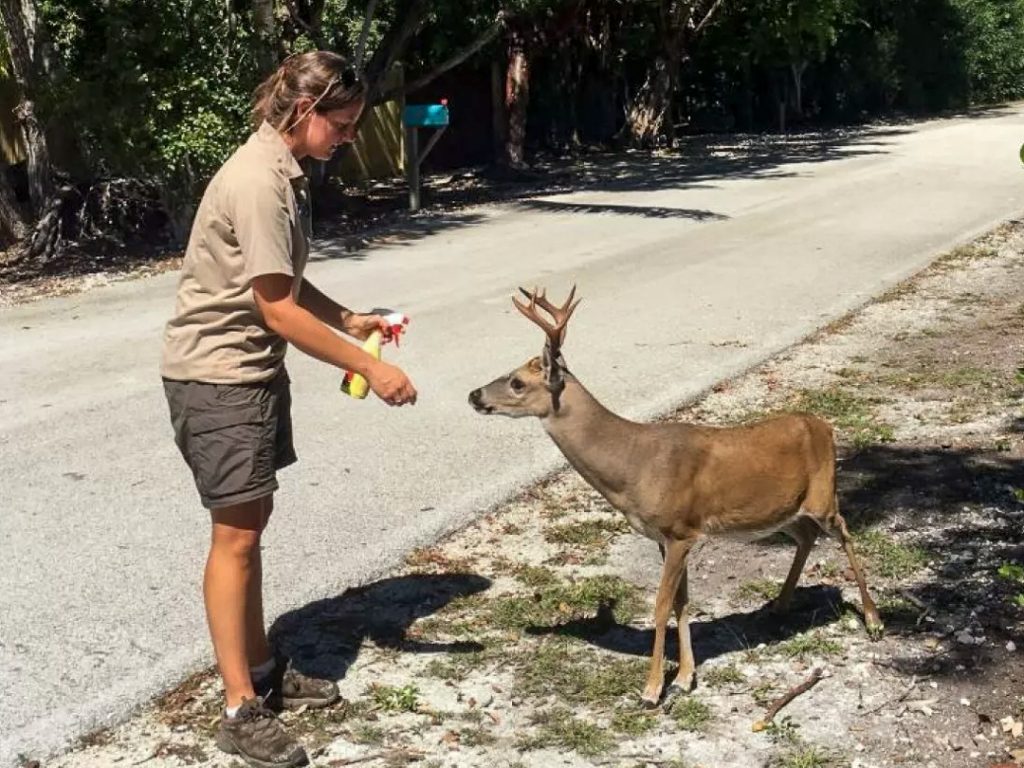Conservation Conundrum: Key Deer
For immediate release ‐ April 01, 2022
Contact: Jon Pishney, 919.707.8083. Images available upon request
 A Florida Keys National Wildlife Refuge biologist feeds a Key Deer food laced with an anti-parasitic drug that combats flesh-eating screw worms, before marking it with non-toxic paint to indicate it’s been dosed. Photo: Chris Eggleston/FWS.
A Florida Keys National Wildlife Refuge biologist feeds a Key Deer food laced with an anti-parasitic drug that combats flesh-eating screw worms, before marking it with non-toxic paint to indicate it’s been dosed. Photo: Chris Eggleston/FWS.
Key deer have been in the news quite a bit lately due to questions about their long-term survival and their protected status.
The endangered Key deer is the smallest subspecies of white-tailed deer. They are unique to the lower Florida Keys, and are found nowhere else in the world. They are the only large herbivore in the Florida Keys and can be found in every habitat, where they feed on dozens of native plant species. They travel through all the Florida Keys habitats, and can walk, wade or swim from island to island. Poaching and habitat loss had reduced the number of Key deer to only a few dozen animals by the 1950s, but establishment of the National Key Deer Refuge and subsequent listing of the deer as endangered in 1967 has allowed for protection and a dramatic recovery of the species. (Source: USFWS)
“The Key deer represent an interesting conservation issue to say the least,” says Mike Cove, the Museum’s research curator of mammalogy. “I personally consider them a ‘conservation conundrum.’ For the most part, the deer have reached many of the recovery criteria – they have robust populations across most of the Lower Keys (their historic range) and in many cases they are in fact overabundant. This is easy to fathom when you consider they are smaller white-tailed deer that have no predators and no hunting to manage their populations.”
“This is where it gets complicated. Key deer can reach local densities that are high enough to cause changes to plant communities and are likely having a negative effect on other endangered species. For example, the deer have decimated many of the host plants for the endangered Bartram’s hairstreak butterfly, to the point where they have not been observed in the Lower Keys for more than five years now.” Key deer also selectively eat up a lot of the good plants that provide habitat cover and food for the endangered Lower Keys marsh rabbits, the species that Cove originally went to the Keys to study in 2012. “Ultimately, climate change and the associated sea-level rise will drastically reduce the habitat for all species in the Florida Keys. Obviously this will have major repercussions for all the people that call the Keys their home as well.”
Cove co-authored a recent paper (published in Landscape and Urban Planning) that looked at how urbanization affects key deer behaviors in the absence of predators, an increasingly relevant topic as many top predators face extinction in the white-tailed deer’s mainland range: https://bit.ly/KeyDeerUrb
For more information about our upcoming activities, conservation news and ground-breaking research, follow @NaturalSciences on Instagram, Twitter and Facebook. Join the conversation with #visitNCMNS.

